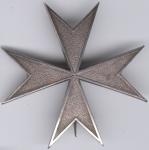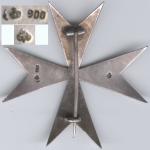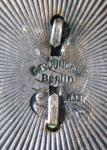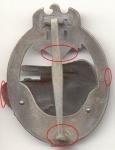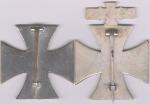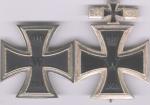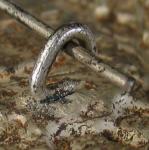
Mike K
For Deletion-
Posts
583 -
Joined
-
Last visited
Content Type
Profiles
Forums
Blogs
Gallery
Events
Store
Everything posted by Mike K
-
Hi, Joe, nice looking example but double check and make sure the core has not been repainted. The frames look worn but the black paint looks 100% - it's a bit unusual. There are several variations of this type of cross. Almost all are vaulted though. The only markings I've seen are for silver (hard to find those ones!). Cores can be steel or non-ferrous. Frames can be silver, nickel-silver or silver-plated tombak. The catches can be "square"-wire or roundwire. Your example has a slightly different pin shape to Tony's example (which imo is the "classic" shape for this type of hinge). Regards Mike
-
EK 1914 another 1914 EK 1
Mike K replied to joe campbell's topic in Germany: All Eras: The Iron Cross
No, it does not, as I stated above. Looks SIMILAR, but it's different - width/thickness of my "square" pin = 2.17/1.46 mm, width/thickness of Joe's type in my collection = 2.60/1.70 mm I agree, I am not aware of any marked and vaulted CD 800 examples. Whether vaulted examples are private purchase or not is probably not critical to the discussion. More interesting to point out that most of the larger manufacturers produced both flat and vaulted examples. I agree that we've got two variations from the same manufacturer - imo whoever produced CD 800 examples! The cores are not identical - period. It does not matter how similar they are, they came from DIFFERENT DIES. Therefore they can not be the same setup. Imo a very important point, one on which I personally have zero tolerance. Further, after examing the frames of the two types (square and "Joe's" type), there are very few differences - there are some, but not many. The most significant differences in the beading lies at the outer right hand point of the 12 o'clock arm and on the inner point between the 9 & 12 o'clock arms. The frames on Joe's type and the CD 800 are imo a match though. Now having said all that, there is one arguement that I will accept - as quite a few of the main manufacturers seem to have had 2 cores and sometimes two frames (eg KO, Godet, Meybauer, WS, Fr, FR, etc) it's possible that all 3 examples under discussion here (Joe's type, "square" type and CD 800) were made by the same manufacturer. Regards Mike -
EK 1914 another 1914 EK 1
Mike K replied to joe campbell's topic in Germany: All Eras: The Iron Cross
Hi Joe, The additional images imo confirm what I indicated above - the core and catch of your example matches "CD 800". Regards Mike -
EK 1914 another 1914 EK 1
Mike K replied to joe campbell's topic in Germany: All Eras: The Iron Cross
Hi Joe, I'd like to ask for a really good image of the core of your example - especially the crown and the date. From what I can see so far, I disagree that this is an unmarked "square" example. Reasoning; The "square" maker and CD 800 crosses are VERY similar but there are some slight variations in their cores. The CD 800 crowns are slightly different and have poorer details than the "square"examples. On the dates, the 1 between the 9 and the 4 almost touches the 9 whereas on the "square" example there is quite considerable separation - from your images the top of the 1 is definitely almost touching the 9. Also, I'm willing to bet that your example has flat-based "flatwire" catch rather than the typical "square" roundwire catch - the flat-based "flatwire" catch is classic "CD 800". The hinges on both types are very close but you'll find the pins on the "square" examples are slightly thinner than on this example. Imo, your example is a vaulted but only 800 stamped CD 800. I have his brother, but the core is not as nice. Regardless - it's a very nice cross! Regards Mike -
Hi Don, As mentioned elsewhere, both look original but both have cracked cores and imo both have been heavily polished - these are NOT mint imo, they just look "nice". Regards Mike K
-
Hi, I've just received a really ugly looking Wound Badge. It is painted black (very sloppy job imo), however there appears to be a worn fire-gilt finish underneath. In places, there also appears to be the remnants of a SILVER finish over the gilt and under the black! I'm really leaning towards stripping the black finish off this badge - not to increase value but because I don't think it belongs. I have already tried acetone on a small test area and the black finish can indeed be removed quite easily. Before I proceed with a full paint strip, I'd like to know if there is any precedent for an originally finished gold would badge to be converted to a black? I don't want to be inadvertently be destroying genuine history! Regards Mike Here's a scan of the obverse. The yellow circles outline areas of fire-gilt finish. The grey circles highlight areas where a silver finish is poking through.
-
-
Hi, Waiting for me on my arrival home was a cross (not an EK1) with a variant cloverleaf JHW marking - a thin stamping with the bottom of the letters towards the center of the marking. The markings are very crisp, although the scans are blurry. Thought some might be interested. Regards Mike
-
Hi Les, IMO, the pin is not replaced on this example. Regards Mike
-
Hi John, I can only agree with John & Jan - a reverse pic is required - as is a bigger obverse pic imo. I can't see a notched swas so I was thinking Deumer but from what I can see of the wreath (especially the shape of the oak leaves) it matches neither Juncker or Deumer. Regards Mike
-
Hi Eric, Sorry for the delay, I've been on holidays for a week. Not an easy one to evaluate from these pics. Cab you confirm that the tank is indeed a separate piece? It almost appears to be cast with the wreath but may only be the small pics and angle of the badge. I realise the badge appears to have some oxidisation, however there are some areas of poor/deformed detail. Also, on the reverse, where the tank tracks protrude beyond the wreath, I do not recall seeing the tracks of known genuine examples in profile as they are here. The area behind the swas almost appear flush/flat on this example, whereas on genuine examples there should be a sharp edged relief in this area. The main pin does not look correct as Rick has indicated. Also, I think the catch is too long and too narrow and the offset "rounded-rectangular" footprint around the catchmound is very poorly defined on this example. Any chance of an image of the catch profile - taken from the bottom of the badge? For me, the inner rim of the number box apears too thick compared to originals. Obverse acorn deail looks poor from the pic and the maker mark, although offset which can be OK, appears to have poor detail. One of the latest good repros shares this poorly formed maker mark. From these images, I have some strong doubts about this example. Regards Mike Some pics highlighting some questionable areas.
-
Hi Darrell, As per the other forum - a copy & paste!; The badge appears genuine however it also appears to have suffered some serious damage in the form of a very bad "knock" which is very evident on the reverse right hand side of the wreath. The central enameled square is either a repair or imo more likely to be a total replacement (it may not even be a genuine replacement) - you can clearly see that there are no "lugs" holding it onto the reverse and it does not fit onto the bent obverse correctly. Also, the silvering on the edges of the enamel disc is imo a plating, not solid silver as per original squares. The catch appears to have been worked on as well - possibly broken and replaced, possibly only the tip broken off and the remainder bent over. Bottom line for me, genuine (unless dimensions indicate otherwise) but damaged and probably messed with. Imo it should not command anywhere near the price of an undamaged example. Regards Mike
-
Hi Tony, Nice example with great patina! Fair price too. Are you going to look for the WS variants as well? Dan, chuffed is good. CHAFED is bad, and cream is beter than powder, unless you're changing nappies! Regards Mike
-
Hi Dan, That is an extremely interesting badge. Many thanks for digging it up! Rick, I know what you mean re the spider-web pattern that forms as a result of fake aging. If you look closely, the badge I've imaged does NOT exhibit a spider-web pattern. The obverse has some patchy rust and the rust on the reverse, although heavier than the obverse, is again patchy. The rust is over an imo correct silver plate - unlike those fake patinas which appear to be over basemetal. Some of the rust is lighter and possibly fresher, but most of the rust appears old and has pitted/corroded the basemetal. For what it's worth, the badge is clearly die-struck - no indications of casting imo. Regards Mike
-
-
Hi, Earlier 57er versions of the 1914EK1 are available, but not that common. Here are the two I own. Both have pressed steel cores. The hinge/pin/catch assembly to me indicates a slightly later manufacture date than the two at the top of the thread, but still way earlier than the 80s to recent "collector's" examples. Note that all examples share the same core, which is also very similar (if not the same) as 1914EK1s produced during WW2. Regards Mike
-
Hi Rick, Thanks for that - I was not aware of the beginnings of an apparent flood. Live and learn. It will have to do as a decent filler until the elusive genuine Bavarian Pilot's Badge comes my way! Regarding the style of crown on this example though, have a look at Chalif's book (published in 1982) at the Bavarian Observer Badge (G-B-2) on P132. Regards Mike
-
Hi Rick, This is a hard one. One thing is for sure, it can NOT be compared to Juncker examples so let's keep those out of this discussion (apples v's oranges imo). There are many differences, mainly in the "central" detail of the artillery bursts, tank and "ground" features. There are Juncker marked examples of this type, however they are raybacks with shallow scoops behind the skull (crown marks too from memory) and I immediately put them into the same category as Juncker "crown" flight badges Meybauer flight badges with non-Meybauer pins (and shallow areas behind the crown). I have one with the same obverse design as yours Rick, but it has a very different hinge/pin arrangement. My example has a Meybauer-like main pin, but not an early Meybauer pin which tend to be thinnner and better formed than the later (30s) slightly chunkier pins. I wish Detlev had shown the Obverse of his early Meybauer example on the bottom left of P158 in his new catalogue - it would have helped immensely! Winkler has just sold one of this obverse design type; a hollow rayback example with Meybauer mark but not a Meybauer pin - it came with a Detlev COA as well (which seems to be the only provenance for one of the few accepted Juncker examples - I don't know of any example with direct German veteran provenance). I have other examples of this type on file, no two of which seem to have the same hinge/pin/catch arrangement. Some of them appear to be obvious poor quality fakes though. When it comes to this type I don't think there is hard evidence either way. Personally, there seems to be some indications that Meybauer is involved. Exactly what constitutes an original Meybauer is unknown to me. I feel my own example is of good quality so I live with the possibility that it is pre-40ish. This one also appears to be of good quality so maybe it's a pre-40 example (whether purchased by a qualified recipient or used as a store/museum display), maybe it's a high-end post-WW2 fake, I don't know. Regards Mike
-
The badge appears to have been in this form for quite some time - not a recent alteration imo. If it was not originally produced like this, I can only think of a few of possibilities; - it is an old repair job - it is an old attempt to increase the value of a cliche Prussian Pilot's Badge by removing the Prussian crown and adding a Bavarian crown - how much value would that actually have added though? - it is an old fake, in which cliche flight badges are nowhere near as safe as I'd thought. Will be interested to hear other's thoughts. Regards Mike



